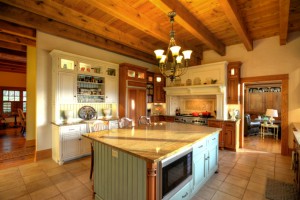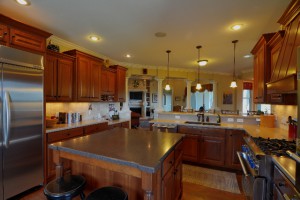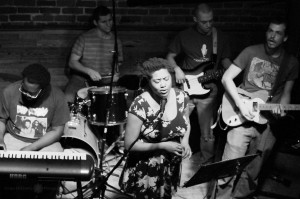 You don’t need us to tell you that selling your home is a monumental decision. Not only do you have to think about finding somewhere else to live, you’ve got to tie up loose ends at your current residence, make sure your potential new dwelling has all the necessary amenities, and convince your kids that they will indeed make friends at the new school. It’s not exactly a relaxing process and, chances are if you’ve found your way to this posting, you’ve probably already decided to sell your place. We here at Gayle Harvey Real Estate have put together this guide full of helpful things to keep in mind.
You don’t need us to tell you that selling your home is a monumental decision. Not only do you have to think about finding somewhere else to live, you’ve got to tie up loose ends at your current residence, make sure your potential new dwelling has all the necessary amenities, and convince your kids that they will indeed make friends at the new school. It’s not exactly a relaxing process and, chances are if you’ve found your way to this posting, you’ve probably already decided to sell your place. We here at Gayle Harvey Real Estate have put together this guide full of helpful things to keep in mind.
The good news is that it’s a pretty good time to sell. According to Time Magazine*, housing prices have increased, more people are looking into/able to buy, and interest rates are still low, creating incentive for potential buyers. This is especially true for real estate in Charlottesville and other areas; with several recent accolades celebrating food, culture and overall living, homes in Charlottesville and other property around central Virginia have more demand than they seen for quite awhile. Let’s get started with some important things to keep in mind before or as you put your home on the market. Presentation is obviously important, and it spans a variety of senses (from the look, lighting and feel of the place to the way it smells), areas (in/outside your home) and times. As soon as you know you want to sell, start thinking about some of these things.
Cleaning up and depersonalizing
Who’s cleaning the house? It depends on your needs and the current state of the house. If you’ve got a few empty rooms once inhabited by college-age kids, you may be able to handle most of the cleaning yourself. As important as actual cleanliness is your commitment to reducing clutter and accumulation. It’s tough to say goodbye to some our long-standing possessions, especially during a move. Owning a home is a testament to stability and structure, and when you’re selling it and trying to limit the number of things you take with you, it speaks to an ephemeral transience which informs the human experience. Consider hiring a professional organizer with whom you can consult as to what to take, what to toss, and what to do with the things you choose to leave behind. You should make a concerted effort to depersonalize your home, especially when interested parties are coming by to see it. Think about removing some of the personal touches; photos of the family, Christmas stockings, banners and tapestries. Potential buyers don’t want to live in a world of your experiences; they want a blank canvas, something onto which they can project their hopes, passions, and humanity. People want to “see themselves” in the space. Think about this when painting too…use neutral colors and steer clear of expressive, “loud” colors like yellow and purple. It’s easier for someone to envision his or her self in a place with muter, unobtrusive colors. You may get people who like the purple, but they’d probably paint it purple themselves either way.
Long-term improvements
If you’re still in the planning stages, now’s the time to start thinking about long-term steps. Investigate funky smells and any errant damp patches around the house, especially if the smells are sort of musty. It could be mold or mildew. Sometimes it’s not particularly difficult for you to get rid of yourself; some good detergent and a bit of cleaning should take care of it. You might also consider a humidifier for patches of moisture around the house. But if you come across a concentrated area of mold over 10 square feet, you should probably seek professional assistance. Look for water issues in your bathroom as well. A squishy floor requires immediate attention and will definitely cost you some money off the asking price, some potential attention from buyers, or both. It could be something as simple as a toilet pan with a leak, or the damage could be more foundational. Either way, you ought to nip it in the bud way before the open house rolls around. Make sure there aren’t any excessive cracks in the foundation (we’re talking 1/8 of an inch or bigger) because that could mean the structural integrity of the home requires attention from an engineer. Also pay close attention to the baseboards, corners and crevices in your house. You’d probably know whether or not you had a full-blown infestation, but roaches and mice don’t need huge spaces to slip by unnoticed. Be on the lookout for termite wings near windowsills as well as little holes or traces of sawdust on the baseboards (carpenter ants). The roof is another very important consideration. If you’ve got extra time and or money, consider a re-shingling job. The age of the roof is definitely something to think about when looking into a new house, and for good reason. It’ll run you at least a few thousand depending on what type of shingles you use. Laminated shingles are the best but also the most expensive. If the roof appears to be faulty or even just old and worn, buyers could try to leverage it into subtracting money off of your asking price, and sometimes this will outweigh the cost of repairing the roof yourself.
 Kitchen and bathrooms are important
Kitchen and bathrooms are important
You may think you’re in the process of selling a house, but in actuality you’re selling a kitchen (and in some cases a master bathroom). It sort of makes sense; the kitchen is probably the room that will attract the highest volume of traffic. It’s also one of the only unique rooms in the house (there are multiple bedrooms, bathrooms etc.) You want your whole house to look good of course, but make sure your kitchen is in tip-top shape for potential buyers. However, we don’t necessarily advise breaking the bank to accomplish this. If you drop thousands of dollars on long-term improvements, it’s not certain that you’ll make that money back. Start off with the more cost-effective repairs and additions. The effect will still go a long way towards winning over potential buyers. We’re talking about things like leaky faucets, shaky light fixtures, and loose drawers. Replacing the cabinets isn’t too pricy and goes a long way towards revitalizing your kitchen and giving it a fresh look. However if the hardware in your kitchen is a little outdated and you have some money to spend, you might think about replacing an appliance or two. Carting that old musty fridge away and replacing it with an ice-making stainless steel behemoth will make buyers think that the rest of the kitchen is at least up to that standard.
The same goes for the bathrooms. Assuming they’re free of the aforementioned water damage, there are still a couple of things you can do to spruce them up. Make sure all the faucets are working and check to see if every sink and bathtub drains quickly. If not, grab some Drano, lye or a plumber’s snake if you prefer to work without chemicals. Replace the shower curtains and, if necessary, any shower and toilet mats you have. Getting a brand new toilet is relatively inexpensive (a few hundred dollars). Consider changing the light fixtures to give the room a brighter appearance, and maybe re-grout the tiles as well.
Open Houses and Showings
Up until now, we’ve been discussing improvements and techniques that are more long-term. Here we’ll go over things to keep in mind in the days leading up to an open house. You should be ready to show a house at any time. Treat every day like it’s an open house. When you get a call from your broker last minute at 6:30 pm, the interested party at the other end of the transaction is probably fed up with the houses s/he has seen. This isn’t a hard and fast rule of course, but a person just starting out a house search is looking at scheduled open houses and making appointments. Spur of the moment showings indicate that the buyer is trying very hard to find a place and hasn’t quite succeeded yet. So the house should always be show-ready.
Start by tidying up the exterior; make sure it looks inviting. An unappealing exterior loses a sale the same way a beautiful kitchen makes one. Fix any cracks in the siding, refurbish the brick, and think about power washing driveways and front steps. Repainting the front door could be a good move as well, so long as the updated paintjob doesn’t make it clash with the rest of the façade. In fact, there are many places inside the house where a fresh coat would go a long way…identify these areas and remember to keep the colors muted. Keep the lawn freshly mowed, trim the hedges, and patch up any fencing. These are things the new owners could easily do, but they are a reflection of you and your upkeep of the house.
Lighting is also crucial in this regard. If you have ample natural light, open up the windows or draw the blinds to showcase that. If there’s not so much natural light, get new light bulbs with higher wattage, more transparent lampshades…anything. You want it to be bright and inviting in your house. Try to avoid drawing attention to dark corners. Move furniture around to maximize floor space. You want to display the most efficient utilizations of the floor plan and you definitely don’t want buyers to think it’s cramped. No one ever complains that a house has too much room. If your closets are bulging, take half of the clothes out and stash them so the closets look bigger. Make sure all the closets are on track too. It’s a quick fix, and shaky closets, like loose doorknobs and leaky faucets just give the impression that the house hasn’t been well maintained. They’re all quick fixes for the people who may end up moving in, but they’ll just contribute to negative impressions of the house.
Avoid any strong smells during this period. Save that delicious chicken tikka masala recipe for the new place; we advise against pungent aromas at open houses, even if they’re savory and appetizing. It goes back to that blank canvas thing. People may also assume that those smells come with the house. For this reason, we’d also suggest treating your lovable Doberman to doggy vacation for a week or two. Not only may you intimidate people who aren’t comfortable around pets, the smell and dander may detract from the first impression. You can’t be sure which of your potential buyers has a negative association with the smell of kitty litter. Fish are okay. Use discretion when decided whether or not to take your terrarium somewhere else, but if you’ve got snakes you may want to let a friend borrow them. Remember, a first impression is likely to be the only impression; the people coming by your place are looking at comparable properties. They’re roughly the same price range and will have many overlapping features, so the only things a potential buyer has to differentiate (besides the objective specs and asking prices) these homes are the experiences that they take. A lot of people will have freshly baked bread or cookies somewhere in the house. Cookies. You’d be hard-pressed to find a person who doesn’t like cookies, although they’re out there. While we’re on the subject of food, think about crafting a light, generally accessible menu for the open house. You’re not opening up a restaurant, given. But a carafe of pinot noir with some camembert or fontina cheeses, some salami? You’re cultivating an atmosphere. A bouquet of flowers at the entrance is a nice touch as well.
This may go without saying, but sweep up and wipe down surfaces before any open house. Make sure the bathroom and kitchen are spotless. When sweeping up, pay special attention to the baseboards and the corners. Wipe the dust off fan blades. Make sure the dishes are clean and the sink is empty. Pretty much hide any evidence that a) you actually use any of the appliances b) you even live in the house at all. Because soon, you won’t. Someone else will be, and hopefully they’ll be writing you a nice check as well.
*http://time.com/money/3629800/housing-outlook-2015/
 Charlottesville is often touted for having a big city-in-a-small town vibe. That is to say it offers up metropolitan amenities without sacrificing a local atmosphere. Nothing demonstrates this duality better than the thriving music scene, in which a plethora of venues—ranging from gritty, 100 person dives to massive arenas like John Paul Jones Arena and Scott Stadium—attracts and maintains a diverse roster of young, up-and-coming musicians, seasoned veterans, and everything in between. Imagine a night on the Downtown Mall, going to see nationally touring acts like the Alabama Shakes, Beck or Snoop Dogg at the spacious, outdoor nTelos Wire Pavilion. After the show, you might hear a lumbering upright bass or the mellow croon of an alto sax and pop into the premier jazz spot, Miller’s, where Charlottesville’s own Dave Matthews used to bartend before he hit it big. Between the John Paul Jones Arena and Scott Stadium (UVA’s basketball and football venues respectively), you will be able to see a number of true legends; acts like Paul McCartney, the Rolling Stones and Fleetwood Mac are never more than a few miles away. Cville’s location—about an hour away from Richmond and a couple hours from Washington, D.C.—affords it the luxury of attention from both big and burgeoning musical acts. You get the option to see amazing acts without compromising the ability to go to sleep before 2am.
Charlottesville is often touted for having a big city-in-a-small town vibe. That is to say it offers up metropolitan amenities without sacrificing a local atmosphere. Nothing demonstrates this duality better than the thriving music scene, in which a plethora of venues—ranging from gritty, 100 person dives to massive arenas like John Paul Jones Arena and Scott Stadium—attracts and maintains a diverse roster of young, up-and-coming musicians, seasoned veterans, and everything in between. Imagine a night on the Downtown Mall, going to see nationally touring acts like the Alabama Shakes, Beck or Snoop Dogg at the spacious, outdoor nTelos Wire Pavilion. After the show, you might hear a lumbering upright bass or the mellow croon of an alto sax and pop into the premier jazz spot, Miller’s, where Charlottesville’s own Dave Matthews used to bartend before he hit it big. Between the John Paul Jones Arena and Scott Stadium (UVA’s basketball and football venues respectively), you will be able to see a number of true legends; acts like Paul McCartney, the Rolling Stones and Fleetwood Mac are never more than a few miles away. Cville’s location—about an hour away from Richmond and a couple hours from Washington, D.C.—affords it the luxury of attention from both big and burgeoning musical acts. You get the option to see amazing acts without compromising the ability to go to sleep before 2am. 

 You don’t need us to tell you that selling your home is a monumental decision. Not only do you have to think about finding somewhere else to live, you’ve got to tie up loose ends at your current residence, make sure your potential new dwelling has all the necessary amenities, and convince your kids that they will indeed make friends at the new school. It’s not exactly a relaxing process and, chances are if you’ve found your way to this posting, you’ve probably already decided to sell your place. We here at Gayle Harvey Real Estate have put together this guide full of helpful things to keep in mind.
You don’t need us to tell you that selling your home is a monumental decision. Not only do you have to think about finding somewhere else to live, you’ve got to tie up loose ends at your current residence, make sure your potential new dwelling has all the necessary amenities, and convince your kids that they will indeed make friends at the new school. It’s not exactly a relaxing process and, chances are if you’ve found your way to this posting, you’ve probably already decided to sell your place. We here at Gayle Harvey Real Estate have put together this guide full of helpful things to keep in mind. Kitchen and bathrooms are important
Kitchen and bathrooms are important